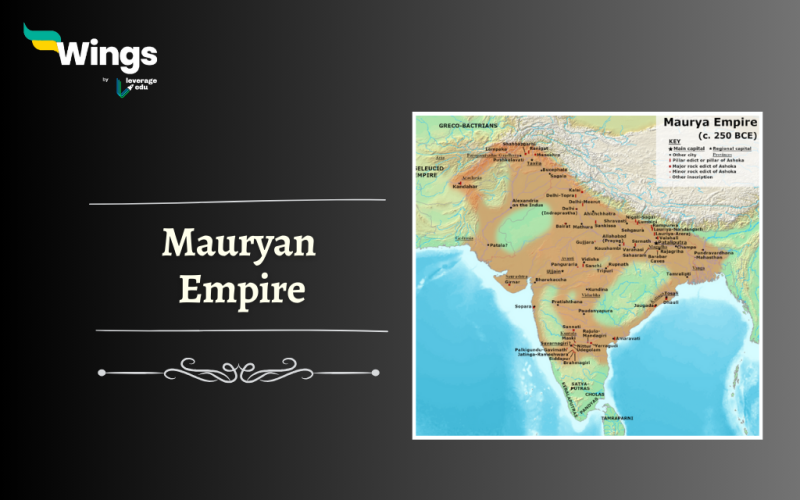The Mauryan Empire was a vast and powerful kingdom that was established by Chandra Gupta Maurya. It was later declared the first pan-Indian empire covering the largest parts of the Indian Subcontinent as well as countries in the west. Moreover, the centre of this massive kingdom was Patliputra on the pains of the river Son and Ganges (Ganga).
Table of Contents
The Rise of the Mauryan Empire
The Empire rose after defeating the Nanda Empire rulers in Patliputra, or modern-day Patna. Chandragupta Maurya did so with the help of Kautilya, also known as Chanakya, who was a great scholar and learned man of the era. Additionally, all the events took place after the death of Alexander the Great from whom it is suspected that Chandra Gupta Maurya learned the art of war. The details of the empire are shrouded in mist because of the lack of evidence in the earlier phases. However, Kautilya’s Arthshastra and Ashoka’s Edicts are the main sources to shed light on the empire.

Important Rulers of the Mauryan Dynasty
The empire was established, flourished, expanded and declined during the reign of these four rulers. Chandra Gupta Maurya established the Empire and it was when Ashoka became king that it was at the peak of its glory in terms of expansion. However, the downfall of the empire started right after the fall of Ashoka. The four important rulers were:
- Chandra Gupta Maurya
- Samudragupta Maurya
- Bindusara
- Ashoka

Administration and Governance
Furthermore, the Administration and Governance of the Empire were as follows:
- During the reign of the Empire, the imperial capital was Patliputra. The rest of the empire was divided into four provinces, namely Tosali (in the east), Ujjain (in the west), Suvarnagiri (in the south), and Taxila (in the north).
- The princes’ of the Mauryan Empire used to manage these provinces. They were helped by the Mahamatyas and a council of ministers. Moreover, the model of governance was centralised and Patliputra practised the same structure of council as the provinces.
- Additionally, the currency was silver and copper coins and revenue was collected from land, irrigation, shops, customs, woods, ferries, mining, and pastures. Such a centralised and well-maintained system was established for the first time in South Asia.
- This structure was strengthened and powered by a strongly divided military system and a powerful judicial system. The caste system was also breaking down as Kautilya encouraged people from all backgrounds to join the army.
- Brahminism, Jainism and Buddhism were the main religions followed by the people of the Mauryan kingdom. In addition, the rulers of this massive empire were learned, trained, courageous, smart and powerful making it one of the most remarkable Empires in history.
Also Read: Kalinga War
The Fall of the Mauryan Empire
After the exit of Ashoka, the decline began of the empire. There are several causes of the Fall of the Empire they are as follows:
- Brahmanical Reactions: The Brahmins wanted a policy that would favour them and uphold their existing interests and privileges. As Ashoka followed Buddhism he prohibited the killing of animals and wanted women to perform rituals too. This naturally affected the income of the Brahmins.
- Financial Crisis: The enormous expenditure on the army and the payment to the bureaucracy created a financial crisis for the Empire. It seems that Ashoka made large grants to the Buddhist monks which left the royal treasury empty.
- Oppressive Rule: During the reign of Bindusara, the people of Taxila complained about the misrule by the bureaucrats. Ashoka tried to address their grievance during his rule but similar complaints arose again.
- New Knowledge in the Outlying Area: Since Magadha owed its expansion to certain material advantages. The spread of this knowledge of these elements such as the Gangetic basin to central India, the Deccan and Kalinga due to the expansion of the Empire gave away the heart of the Empire. Moreover, the regular use of iron tools and weapons in the provinces nearby also coincided with the decline of the Empire.
- Neglect of the North-West Frontier: As Ashoka mainly focused on missionary activities at home and abroad, he failed to pay attention to the safeguarding of the passage on the north-west frontier.
Thus, the Mauryan empire was finally destroyed by Pushyamitra Sunga in 185 BC and the Sunga Dynasty began.
FAQs
The Mauryan Empire was known for its unity in politics as well as internal peace which further promoted the expansion of trade in India. Moreover, the Mauryan Empire is also known for the reign of Ashoka and Chandragupta Maurya.
The Shunga Empire defeated the Mauryan Empire in the 185 BC.
The Founder of the Mauryan Empire was Chandragupta Maurya in the year 321 BC.
The 3 Kings of the Mauryan Empire were Chandragupta Maurya, Bindusara, and later Ashoka.
Ashoka was defeated by Pushyamitra Sunga of the Sunga Dynasty.
Relevant Blogs
| Chalukya Dynasty | Post Mauryan Period |
| Pallava Dynasty | Rashtrakutas Dynasty |
| Chera Dynasty | Chauhan Dynasty |
| Pala Dynasty | Gupta Empire: Rise, Rulers, UPSC Notes |
| Shishunaga Dynasty (413 BCE to c. 345 BCE) | Pandyas |
We hope you liked what you read. For more such informative blogs on Indian History stay tuned to our General Knowledge section.
 One app for all your study abroad needs
One app for all your study abroad needs













